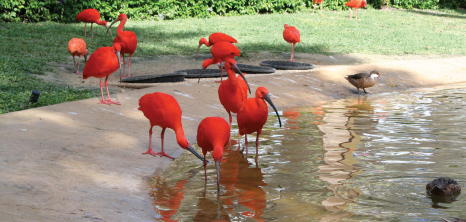|
Species of BirdsBarbados has a variety of bird species that make this island their home and a few that are even extinct. Some of existing species include but are not limited to blackbirds, egrets, pelicans, sparrows and wood doves.
DescriptionBirds can easily be regarded as an astounding set of creatures. Classified as warm-blooded, they are from the family of vertebrae (meaning they have a backbone). In a category all on their own, they are the only set of animals with feathers and the unique ability to fly. However, some birds like the ostrich and penguin are among the few that are unable to fly, as their way of living lends itself more readily towards land or water.
Quite unique in their make-up, birds are the only set of creatures with feathers (or plumage). They come in just about every gamut of colour and their purpose varies from species to species. Feathers can function for use in mating, regulation of body temperature, camouflage, flight and even territorial authority. Whether it’s the cold or the tropics, birds are found living comfortably in just about any natural environment.
EyesightAs with pilots, good eyesight is of vital importance to ensure flight safety. That same principle applies to birds. After all, the design of the aeroplane was as a result of man drawing great inspiration from these very creatures.
A birds’ eyes are relatively large in comparison to the rest of the body. In all the animal kingdom, a birds’ eyesight is the most developed of them all. The unique position of their eyes affords them the ability to have sharp vision thus allowing them to recognize objects that may appear obscure by human standards. Birds see in colour, quite unlike the other members of the Animal Kingdom. Digestive SystemIt is important that a birds’ weight is not compromised. Their digestive systems are so wonderfully constructed that once they eat, there is no chance of undigested food staying around as it passes through their systems quickly. This process allows the bird’s weight to stay standardized, thus enabling smooth flight.
Birds don’t have teeth but it is normal for them to eat large quantities of food, especially based on the fact that they have extremely high metabolic rates. The digestive physiology of the bird is as follows:-
Esophagus - narrow tube that conducts food from the mouth to the crop
Crop - the division of the stomach that is used for storing food temporarily in view of it being softened to be passed on to the next stage
Proventriculus - the part of the stomach breaks down food via means of digestive enzymes and passes it on from the crop to the gizzard
Gizzard - made up of thick, muscular walls and used for grinding up food. This process is often aided by grits and small stones that the bird eats along the way
Intestines - here food is mixed with bile and enzymes. The nutrients are then extracted from the food and passed on through the blood stream
Respiratory SystemBirds in flight and birds singing all look and sound sensational to us. It makes you wonder just how they are able to keep up with such demands for air utilization on their bodies.
The most unique characteristic of a birds' respiratory system is the way in which air flows in one direction, which is quite unlike ours. As a result, the limited pressure of oxygen in a birds' lungs is on a par with that of the environment. Hence the exchange of both oxygen and carbon dioxide is a lot more efficient than that of human-beings. Birds are able to inhale a lot more air than normal due to the fact that the lungs are supplemented with a series of air-sacs. These air-sacs keep the lungs constantly filled with air even when the bird is exhaling. This unique and amazing system aids in strengthening the birds’ respiratory system and thereby assisting greatly to the process of flight. The size and number of air-sacs vary from bird to bird as this is all very dependent on how much buoyancy is required during flight.
When compared to other members of the vertebrae family, given their high demand and output, birds sure do deserve the most efficient breathing apparatus they can get. NestingNesting is quite an important and creative aspect of a bird's life-cycle. Built with the purpose of shutting out the elements and possible predators, these nests are truly a work of art. Organic materials such as twigs, grass, leaves or man-made materials such as cotton, cloth or paper, are used instinctively to construct save havens for their young. Many back and forth trips can be made collecting materials in an effort to get the construction of nests off the ground (pun intended). Despite the seemingly hard look and feel of the exterior structure of a bird’s nests, the inside is usually graced with a softer material.
|



